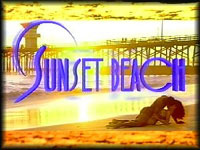March 13, 2006
Bonafide British Person C.J. Quinn covers the strange intersections between British television and American television in...
London CallingDigital Cable Comes to Britain!
The Queen Flees in Terror!
| Having grown up in the backwoods of Maine without
cable, he had only ever known the joys of four TV channels.
In retrospect, that relationship was never going to last. |
In retrospect, that relationship was never going to last.
He was also, therefore, the only American my age I've ever met who understood what it was like to be overwhelmed by the prospect of a hundred channels-worth of nothing to watch. When I went to university, my parents' TV still only received five channels. I'd grown up with the Big Four (BBC 1, BBC 2, ITV and Channel 4), and I remember the excitement of Five being launched in the late '90s — an excitement tempered when we realised all it really showed was the cheesetastic soap opera Sunset Beach, and made-for-TV 'erotic thriller' films that were virtually softcore porn.
 |
Then, on October 30th 2002, God created... Freeview, a free-to-air nationwide digital TV service.
Although many televisions now come with built-in ability to receive Freeview channels via digital receivers, initially you had to buy a set-top box (looking confusingly identical to your VCR) which would let you receive a whole extra 30 or so channels for free. While you still have to pay for satellite or cable if you want to watch 'Alias' re-runs on Sky One or all-new episodes of 'Cribs' on MTV, with a Freeview box (about £30, or $50), you can now receive a bewildering number of variants on the established Big Four. BBC 3, BBC 4, ITVs 3, 4 and 5, More4, E4 and so on... it's a bit like those perfume counters that present you with the choice between CKone, CKBe, CKone Scene and a load of other things that all smell the same when you open the bottle. Add in the host of craptacular shopping channels (Price-Drop TV, QVC et al) and niche interest channels (Men and Motors, Teacher's TV), and you can receive up to 106 channels, plus 25-odd digital radio stations
As of last year, OfCom, the communications industry regulatory body, estimated that 7 million homes in the UK had a Freeview receiver, and this year the number of Freeview-only homes is expected to exceed the number of Sky-only homes for the first time. The steady increase in Freeview homes is just as well, because the Great Switch-Off date grows ever closer. Beginning in 2008, various UK regions will lose the analogue TV signal, and by 2012, the government intends to have switched off the analogue signal completely. From then on, all terrestrial TV in the UK will be digital (or so the theory goes — quite who will sort out all the people too poor to afford new TVs or set-top boxes, and all the elderly people like my granny who think this means they need a computer to watch the telly through, doesn't seem to have been ironed out yet).
| The challenge now for the original Big Four is how to diversify their services to give each of their new channels a distinct identity, without losing their core brands in a mess of 'BBCKids, 'BBCGardening' 'BBC Gay Interior Designer' and so on. |
Brand naming stress aside, the question of what defines the BBC, ITV and Channel 4 brands seems set to be a crucial one over the next few years as the Freeview channels compete with each another, and also with the cable services and SkyPlus, the next evolutionary stage of the pay-for-view Murdoch service. How far can the old channels diversify their services to compete for viewers without diluting their brands beyond the point of recognition? I was amazed to learn that QuizCall, an awfully budget Freeview channel dedicated to ridiculously easy phone-in quizzes (60p a go, mind) is actually owned by Channel 4 — it's a huge money-spinner for the channel, but so hideously cheap and cheesy that Channel 4 didn't want the '4' brand anywhere near it. This kind of sneaky brand value protection may take the big channels some of the way, but will surely lead us down the garden path from the current situation of 100 channels with nothing on, until we attain the awesome US TV nirvana of 600+ channels with absolutely sod-all on. The Big Four are all racing to turn channels into networks, but as they keep splitting and subdividing their output, like amoeba frantically reproducing, will they actually turn out a single thing worth watching?
Email the author.
Return to Season 2, Episode 12.
All written content © 2005 - 2006 by the authors. For more information, contact homer@smrt-tv.com
